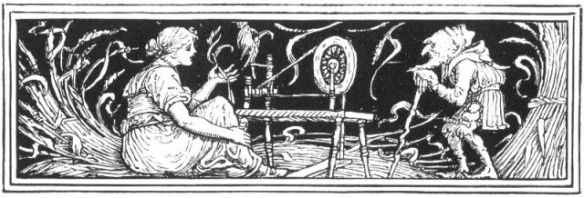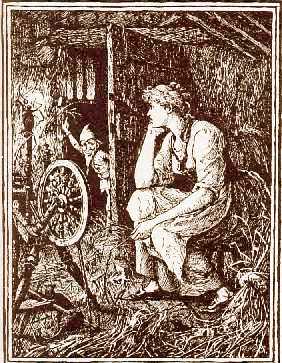
I have a heck of a time typing “Rumpelstiltskin” – the “ltsk” combo in the middle is really hard to get, as no other word I can think of has that sound sequence in English. For some reason, the German “Rumpelstilzchen” flows much easier from the fingers.
However, that’s not the main issue with this fairy tale. The real problem, I decided on re-reading it yesterday, is that the beautiful miller’s daughter (that’s the beautiful daughter of the miller, not the daughter of the beautiful miller – there’s English grammatical ambiguity for you) is screwed coming and going.
I used to like “Rumpelstilzchen” when I was a child. It has an ending that I always found quite satisfying: The nasty manipulative gnome is found out, and in his fury at being thwarted he tears himself in half. Happily Ever After, The End. It never occurred to me that that’s really kind of gruesome – as Max Lüthi says, it’s not a bloody tearing-apart, but a neat separation into two halves; he sort of “falls to pieces” (p.27 of Das europäische Volksmärchen). Thinking about it, I guess I always pictured it more like a piece of paper being ripped in half. Rumpelstiltskin is a paper-flat “bad guy”, so when he tears himself in half there’s no blood and guts, because he hasn’t got any.
And the other thing I didn’t think about as a kid – also due to the paper-flatness of the characters – is that the miller’s daughter, or queen, as she is now, has a terrible husband. In fact, she’s entirely surrounded by awful males. First, her father, who lies about her to make himself look better to the king. Then the king, whose chief – in fact, only – characteristic is greed; he’s ready to murder her if he doesn’t get his way. And then Rumpelstiltskin, of course, who does things for her only for a steep price. Daddy wants glory; ruler (and then husband) wants gold; gnome wants something alive (to, presumably, roast in the fire as the main dish to go with his baking and brewing).
 And what does the miller’s daughter want? Who knows. Well, actually – we do know, or at least as a child I knew. With fairy tales it doesn’t do to overthink. Now that I’m an adult and know something about marriage relationships, the thought of the miller’s daughter tied for life (and having to share a bed!) with a gold-digging murderer – well, it bothers me. But as a kid, I completely glossed over the “Do this by morning or I’ll kill you!” part, and the “even if she is only a miller’s daughter, I will not find a richer wife in all the world” bit, too. I skipped straight to “He married her, and the beautiful miller’s daughter became queen.” Because that, as I knew in my childish wisdom, is the key part. She got to be queen – she is now a woman of power and immense wealth. Who cares about all that mushy emotional stuff? Fairy tale characters aren’t real people.
And what does the miller’s daughter want? Who knows. Well, actually – we do know, or at least as a child I knew. With fairy tales it doesn’t do to overthink. Now that I’m an adult and know something about marriage relationships, the thought of the miller’s daughter tied for life (and having to share a bed!) with a gold-digging murderer – well, it bothers me. But as a kid, I completely glossed over the “Do this by morning or I’ll kill you!” part, and the “even if she is only a miller’s daughter, I will not find a richer wife in all the world” bit, too. I skipped straight to “He married her, and the beautiful miller’s daughter became queen.” Because that, as I knew in my childish wisdom, is the key part. She got to be queen – she is now a woman of power and immense wealth. Who cares about all that mushy emotional stuff? Fairy tale characters aren’t real people.
But that’s where retellings of this tale hit a big snag. In fact, that’s one of the big snags in any fairy tale retellings – they try to flesh out the characters. Where true folktale characters are paper-flat – in Lüthi’s words, one-dimensional – novelisations and adaptations have to go further, have to make the characters “real”. And a woman whose only aim in life is power and wealth is, quite frankly, an unsympathetic character. Sure, she’s a great mate for Mr “Gimme Gold or You’re Dead” King, so her happily-ever-after is believable. But as novel readers we don’t like her, we don’t care for her, and we’d rather hear about what makes Rumpelstiltskin tick (hence Once Upon a Time‘s Rumple/Mr. Gold, who was always the most interesting character in the whole show).
“Rumpelstiltskin” adaptations struggle with the miller’s daughter and her relationship to the king. 21st-century sensibilities don’t allow for a marriage based purely on material consideration being a happy outcome – there’s no “true love” in the picture, so it can’t be any good.
I watched a 2006 movie version last night – here (with English subtitles of a sort – they seem like the product of Google Translate and sometimes spectacularly get it wrong, but they still get at the gist of the dialogue). The movie’s solution to the problem is that the king, young, handsome, and quite un-greedy, falls in love with the miller’s daughter at first sight (he’s quite cute the way he plays it – totally loses his head, can’t keep his eyes off her), and it’s his old, ugly, avaricious chief minister who does the locking her up in rooms full of straw and threatening her life (and that of her father, into the bargain, which makes her keep her mouth shut about it all).
So that’s all good – we’re doing homage to true love, and the bad guys are all, indeed, bad, and get suitably punished (the nasty minister gets drummed out of the castle by the cudgel-from-the-sack, which I liked, it being another favourite of mine). The only one who doesn’t get rapped over the knuckles for his misbehaviour is the lying papa, but as he only told lies in the first place because he’s so proud of his daughter and loves her so much, it’s all okay too.
It was interesting to see how this adaptation changes the original tale to make sure its morals fall in line with today’s ideas of what is good, bad and desirable. Some time ago I was talking about the problem with “Sleeping Beauty” – another tale that has at its core a story element that simply does not fit with today’s sensibilities (the 100-year sleep, in that case). Some fairy tales translate easily – “Cinderella” being one; with others, it seems you can’t take the “original” (17th/18th/19th-century) tale and make it fit today without changing one or more core plot points.
But that’s what makes fairy tale adaptations so interesting, both reading and writing them – how are you going to solve that unfitting plot element? On that note, I might take a stab at “Rumpelstiltskin” myself. Although I’m not sure yet where I’ll go with it, hopefully by the time I’ve typed his name a hundred times or more, my fingers will cooperate. Rumpelstiltskin, Rumpelstiltskin, Rumpelstilt…

Reblogged this on amo vitam.
LikeLike
Excellent points. I agree. I actually haven’t read too many retellings of this one. Michael Cunningham did one in “A Wild Swan and Other Tales”. But in that case the rather irreverent tone and POV avoided having to deal with these issues. I liked Donna Jo Napoli’s “Spinners” , but I think those are the only ones I’ve read…
LikeLiked by 1 person
I read one by Carola Dunn that was a historic romance, a love story between the miller’s daughter and Rumpelstiltskin. Fun, but again turns things on their head.
LikeLiked by 1 person
Well, I might check it out anyway. Just out of curiosity.
LikeLiked by 1 person
Dunn is good, I enjoy her books. Most of them are Regency romances and cosy mysteries, but she has one book with “magic” novellas.
LikeLike
I’m not a fan of Rumplestitskin–that IS hard to write, Lol–but the theme of sexism and the often “between rock and hard place” situations experienced by women once upon a time and all too often comes through eloquently. And that, as you pointed out, this darker theme was often lost on starry-eyed young girls who had been conditioned to believe that marriage was their ultimate goal, is also very clear. There was a time when little girls saw Prince Charming’s face only, and did not notice his shallowness at all. Just a paper character, as you put it. And Rumplestiltskin’s two-dimensional character, gutless, without history, or motivation. All he is, is greed and rage with a face. A metaphor. Not a person at all. Didn’t I do a paper on this theme? Lol. Great post though!! I think you pretty much nailed it.
LikeLiked by 1 person
One of the points here is that Prince Charming is simply not in existence here. “Rumpelstiltskin” is one of those tales that really isn’t at all about “true love” – love doesn’t even come into the picture. All we have here are material considerations, and maybe mother’s love.
LikeLiked by 1 person
Yes. You’re right. I was referencing Prince Charming as an example of shallow male characters that seem to unduly consume female interest. Maybe not unduly since he often offers an escape to a nicer prison…usually. But then that being said, without Prince Charming, the lack of empowered female characters is felt even more intensely, do you think so?
LikeLiked by 1 person
I’m not sure – like I said, the existence or not of Prince Charming is not something I ever paid attention to as a kid. I don’t know that the story is any different for lack of him, as long as the main character gets what he/she wants in the end and the baddie is defeated. I think the Prince Charming thing is a fairly recent phenomenon – possibly thanks to Disney, among others?
LikeLiked by 1 person
Because I don’t recall the Prince Charming in the original fairy tales I read as being actually that charming…or that present. So, good point.
LikeLiked by 1 person